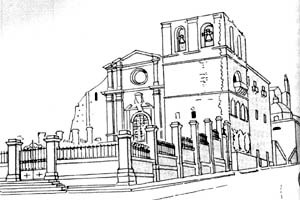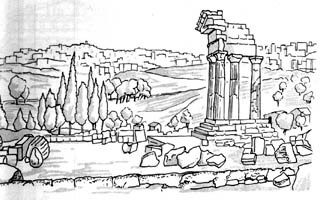| Storia
dei Monumenti Siciliani
Sicilian's Monuments History |
| Agrigento |
| Il Duomo | Tempio di Giove Olimpico | Chiesa di S. Nicola |
 |
|
Eretto nel secolo XI, rifatto nei secoli XIII - XIV (resti visibili) e rimaneggiato nel '600 e nel '700. La semplice facciata è fiancheggiata a destra da un poderoso campanile del trecento mozzo, ornato in basso da due ordini di monofore cieche e da una finestra a balcone gotico-catalana. L'interno restaurato nelle forme medioevali, è a tre navate su pilastri poligonali. La prima metà della navata è ricoperta da un ricco soffitto a capriate, del 1518; la seconda metà ha un soffitto a cassettoni del 1682. Nel transetto a destra è il bel portale gotico che incornicia la nicchia che racchiude la reliquia di S. Gerlando, di M. Ricca (1682). Nel presbiterio, sopraelevato e ornato di stucchi barocchi, si verifica il singolare fenomeno acustico del portavoce: stando presso la cornice dell'abside si ode ciò che dice, anche a bassissima voce, una personacollocata all'ingresso della Chiesa. |
Built in XI Century, rebuilt in XIII - XIV Century (visible rests) and rehandled in '600 and '700. The simple façade is sided to the right from a mighty bell tower of the three hundred ship boy, adorned in low from two orders of blind mono fore and from a Gothic-Catalan window balcony. The interns restored in the Mid-Age forms, it has three aisles on polygonal pillars. The first half of the aisle is covered from arich trusses ceiling, of 1518; the secondshalf has a ceiling to chests of 1682. In the presbytery, upside and adorned of plasters Baroques, the unusual phenomenon isverifiedacoustic of the spokesman: staying one ode beside the frame of the apse what tells,also to low voice, a person entering the Church. |
 |
|
Rimangono dopo le distruzioni causate dai terremoti alcuni colossali resti che lasciano immaginare l'impotenza dell'edificio (mt.113 x 56), uno dei maggiori dell'architettura greca. Era stato eretto a partire dal 480 a. C., dopo la vittoria degli Agrigentini sui Cartaginesi a Imera. Possedeva singolarità costruttive uniche nell'architettura greca; aveva un muro pieno con delle mezze colonne, tra i quali stavano statue gigantesche. I telamoni alti quasi 8 metri, concorrevano a sostenere la pesante trabeazione. Al centro delle rovine si può notare il calco di un telamone ricomposto a terra. A destra del Tempio si apre un vasto complesso sistema di edifici adibiti al culto, e una vasta area ove si trovano numerosi altari di varia forma e grandezza, basamenti di Templi e vari recinti sacri, oltre a numerose fosse.Questo complesso di costruzioni, che risale al secolo VI-V a.C., faceva parte di un Santuario delle Divinità Ctonie, dedicato a Demetra e Persefone, dee della terra. Al centro dell'area emerge il pittoresco gruppo di quattro colonne, divenute l'emblema di Agrigento, del cosiddetto Tempio di Castore e Polluce, sorto nel sec. V. |
After the destructions which caused great damages; colossal rests that leave from the earthquakes let us imagine the potency of the building (mt.113 x 56), one of the greatest of the Greek architecture. It was erected beginning in 480 b.C., after the victory of the Agrigentini on the Cartaginesi at Imera. It possessed constructive unique singleness in the Greek architecture; full wall with the half columns, between which gigantic statues stayed. The tall telamoni almost 8 meters, competed to support the heavy ceiling. To the center of the ruins could be noticed the tread of an upside part recomposed to earth. To the right of the Temple opens a vast complex system of buildings used to the cult, and a vast area where is numerous altars of varied form and greatness, plinths of Temples and varied sacred enclosures, beyond to numerous pits. This complex of constructions, that goes up again the VI-V century [a.C]., was a part of a Sanctuary of the Ctonie Divinities, dedicated to Demetra and Persefone, goddesses of the earth. To the center of the area the picturesque group of four columns emerges, become the emblem of Agrigento, of the so-called Temple of Castore and Polluce, risen in the V. Century. |
|
Eretta dai Cistercensi nel sec. XIII in robuste forme romanico-gotiche, sulle rovine o nei pressi di un edificio antico, della cui architettura riecheggia, e pare utilizzi, alcuni elementi. La semplice ma solenne facciata è racchiusa fra due poderosi contrafforti sormontati da una cornice in forte risalto e ha un bel portale ogivale, con porta in legno intagliata di Angelo di Blundo (1531). L'interno è a una sola navata aperta ai lati da quattro arcate cieche sopra cui corre un cornicione. Una poderosa volta ogivale, con tre costoloni a rilievo di rude architettura, completa questo insieme. |
Erected by the Cistercians in the XIII Century in strong Romanesque-Gothic forms, on the ruins or in the by of an ancient building, of whose architecture resounds, and it seems use, any elements. The soldier the solemn façade have contained between two mighty buttresses surmounted from a frame in strong prominence and which there is a beautiful rounded portal, with door in wood carved of Angelo di Blundo (1531). The interns is made with an only aisle opened to the sides from four blind arcades above which it runs a cornicione. A mighty rounded time, with three embossed groins of rough architecture, complete this together. |
|
|
|
Back to main page |
Site colours design by Grifasi Studio ® - Milano - Italy